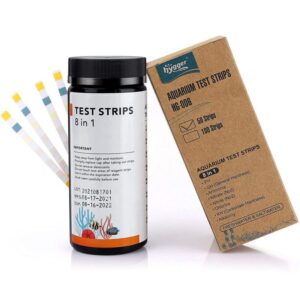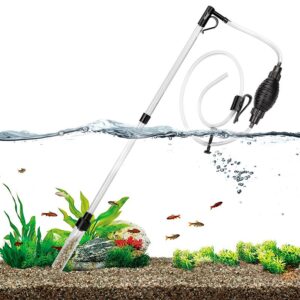Many careful considerations must be made for a healthy aquarium life. One of the most important is the water your fish swim in. Since it contains chlorine, a chemical that is added to make the water safe for human consumption by killing bacteria, tap water can be dangerous for your aquatic buddies.
Content Table
In this article, we will discuss the complete ins and outs of dechlorinated water and whether it’s good for fish or not. We will also share useful tips on how to dechlorinate tap water for aquariums.
What is Dechlorinated Water?
Dechlorinated water is simply tap water from which the chlorine has been removed or neutralized. Chlorine, although vital for purifying drinking water, can have adverse effects on fish, damaging their delicate gills and stressing them. By dechlorinating water, you create a fish-friendly habitat, ensuring the well-being and longevity of your aquatic companions.

Dechlorinated water boasts benefits beyond its fish-friendly properties. It also promotes the growth of beneficial bacteria in your aquarium, which is essential for maintaining a stable and healthy ecosystem. These bacteria play a pivotal role in breaking down waste and maintaining water quality. By ensuring a chlorine-free habitat, aquarium enthusiasts create a conducive and thriving ecosystem, promoting the well-being and longevity of their aquatic inhabitants.
How Long to Dechlorinate Water for a Fish Tank
The duration required to dechlorinate tap water for your fish tank can vary depending on the method employed. Here are some common scenarios about how to dechlorinate tap water.
Immediate Use
Utilizing a water conditioner provides an almost instantaneous dechlorination process. These conditioners, available in liquid or tablet forms, contain active agents that rapidly neutralize chlorine, rendering the water safe for your fish. The application is straightforward – adhere to the product’s specifications for precise dosage, ensuring efficient and swift dechlorination.
Aeration Method
The aeration method employs the natural dissipation of chlorine throughout 24 to 48 hours. Allowing tap water to sit exposed to air facilitates this process. To expedite aerating for aquariums, consider incorporating an air stone or employing the technique of gently pouring water between containers. These methods maximize surface exposure, promoting the efficient removal of chlorine through aeration, thus creating an optimal environment for your aquatic inhabitants.
Boiling Method
The boiling method offers an effective dechlorination strategy by exploiting the release of chlorine as a gas. Bringing tap water to a rolling boil and subsequently allowing it to cool takes approximately 15 to 20 minutes. This technique proves particularly advantageous for smaller water quantities, offering a rapid solution for the removal of chlorine. Boiling, as a dechlorination method, leverages thermal dynamics to ensure the swift preparation of aquarium water with reduced chlorine content.

Ways to Dechlorinate Tap Water
There are several effective methods to dechlorinate tap water for aquarium use.
Water Conditioners
Water conditioners, found in most aquarium stores, stand out as a popular and convenient solution for dechlorination. These products are infused with specialized chemicals that act swiftly to neutralize both chlorine and chloramine upon contact. To ensure optimal results, adhere closely to the product guidelines for dosage. The ease of use and instantaneous action make water conditioners a favored choice among aquarium enthusiasts.
Aeration
Aeration, a dechlorination method reliant on exposing tap water to air, offers versatility in its application. Techniques such as utilizing air stones, allowing water to cascade over surfaces, or simply allowing it to stand in an open container can be employed. The effectiveness of aeration is influenced by factors such as water volume and surface area exposed, determining the duration required for chlorine dissipation. This method provides a customizable and efficient means of ensuring chlorine-free water for aquariums.
Boiling
Boiling tap water is a quick and reliable dechlorination method. Simply bring the water to a rolling boil for 15–20 minutes, allowing chlorine to evaporate. After cooling, the water is ready to enhance your aquarium environment. This method is particularly efficient for smaller water quantities, ensuring a swift and effective dechlorination process.
Activated Carbon Filters
Integrating activated carbon filters into your aquarium’s filtration system provides a continuous solution for removing chlorine and impurities. These filters act as vigilant guardians, ensuring a steady supply of dechlorinated water for your fish. Keep in mind that the effectiveness of activated carbon diminishes over time, requiring periodic filter replacement to maintain optimal filtration performance.
How Long Can Fish Be in Tap Water
The duration fish can safely endure tap water directly correlates with the presence of chlorine. Chlorinated water becomes toxic to fish within an hour or more of exposure. It stands as a leading cause of fish fatalities among hobbyists globally. To safeguard your aquatic companions, it is paramount to use a chlorine neutralizer when performing water changes.
This essential additive swiftly eliminates chlorine, ensuring your fish remains in a healthy and stress-free environment. Prioritize the well-being of your fish by adopting this simple yet crucial measure in your aquarium care routine.
The Bottom Line
In the intricate world of aquarium care, water quality is paramount. Dechlorinating tap water is a simple yet crucial step in providing a safe and healthy habitat for your aquatic pets. Whether you opt for water conditioners, aeration, boiling, or activated carbon filters, the goal remains the same – to eliminate chlorine and create an environment where your pet fish can thrive.
Investing time and effort in dechlorination not only safeguards your aquatic companions but also contributes to the overall stability of your aquarium ecosystem. By understanding the importance of dechlorinated water and adopting the appropriate methods for dechlorination, you ensure a vibrant and flourishing aquatic community that will bring joy and beauty to your home for years to come.


Leave a comment